how to draw a 3d model in autocad

This is a invitee post by Andreea Georgiana. She is a CAD enthusiast who likes using the ability of Reckoner Aided Design to create cool useful designs, from conception to 3D printing. She has a 21-day AutoCAD grade at tutorial45.com.
She says, "Beingness able to use Estimator Aided Blueprint software to bring your ideas to life is one of the things I totally disagree merely engineers should be able to do. With the numerous advantages of being able to movement past the level of a 3D model to really having the model 3D printed, anyone should consider learning at least the basics of modifying a CAD model.
"As a CAD hobbyist, wife and mother, I have constitute many cases where a customized solution designed myself has solved a problem in the verbal manner I wanted, thanks to the ability of CAD and 3D printing. You tin find some free tutorials here."
* * * * *
Before I start, here are 2D and 3D images of the model you'll draw in this tutorial,


Use the images above to assist yous in completing the 3D model.
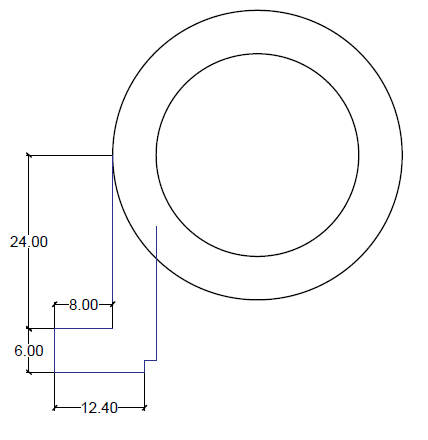
Stage ane: Draw the pipage (circles) and legs (lines)
Make certain the Quadrant and Midpoint in Objects SNAP settings are on. The upper parts of the legs are snapped to the left and right quadrants of the model. Later, you'll apply the Midpoint OSNAP.
Then follow these steps, following the image to the right and below:
- Describe ii concentric circles with R20 and R14.
- Draw a vertical line downwards from the left quadrant of the outer circumvolve 24 units long
- Draw a horizontal line of 8 units toward the left using the lower end of the vertical line y'all just drew as the starting point.
- Draw a vertical line of 6 units downward from the catastrophe point of the previous line
- Draw a horizontal line of 12.4 units rightward from the ending indicate of the previous line
- Draw a vertical line of 1.6 units upward
- Draw a line of ane.6 units to the correct
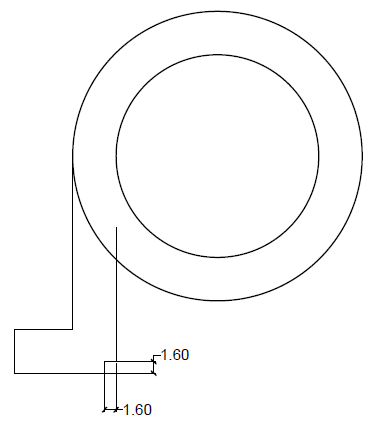
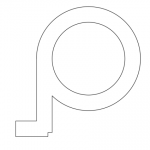
Now follow these steps to trim and mirror the model:
- Use the TRIM command to remove the unnecessary part of the circumvolve. Use the 2 lines that meet the circle equally the cut edges and the part of the circle between them as the object to trim.
- Now mirror this left side using the heart of the circle to create the similar shape on the right side of the circle.
- Trim it to complete this footstep using the TRIM command. You lot should stop upwardly with an image like to the ane below
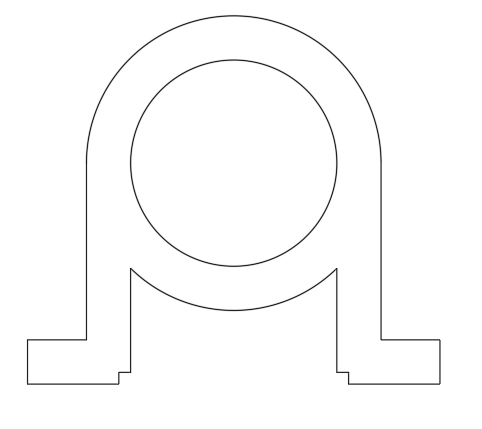
Phase 2: Intermission the circles at the top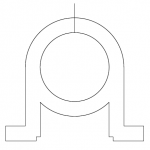
Follow these steps:
- Utilize the Upper quadrant of the inner circle to draw a vertical line that crosses the outer circle. The length of the line does non matter.
- Use the Outset command with the OFFSET dimension set to 1 units to describe 2 lines on each side of the original line.
- At present delete the key line.
-
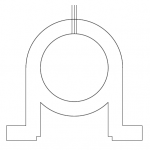 Use the EXTEND control to extend the remaining lines to the inner circle. Yous might need to zoom in to notice that they don't actually intersect with the circle.
Use the EXTEND control to extend the remaining lines to the inner circle. Yous might need to zoom in to notice that they don't actually intersect with the circle. - Apply the TRIM control to trim the two circles as shown in the image beneath. Use the lines as the cut edges.


Phase 3: Add the top
Follow these steps:
- Use the OFFSET control to offset the left line to the left and the correct line to the right with an offset distance of 6 units.
- Trim the new outer lines using the outer circumvolve as the cutting edge., Then trim the top part of the outer circle using the outer lines as the cutting edge.
- You lot want the outer lines to exist seven.2 units long, as shown on the epitome below and then and you need to close the head using a horizontal line.
- 1 mode to do this is to start the LINE command, blazon from on the command line and ready the start to seven.two, moving your cursor up. The draw the LINE horizontally to the left until information technology intersects the outer vertical line on the left. Then trim the parts of the line that extend by the new horizontal line and trim the function of the horizontal line between the 2 inner vertical lines.

Phase 4: Add the bracing (triangle)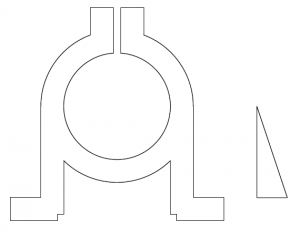
Design the little triangle on the side of the model by drawing a vertical line of 24 units, a horizontal line of 8 units, and then closing the triangle. For now, put information technology out to the side, separated from the main model. Yous can describe on top of the existing lines to first, close the triangle, and and so select each of the 3 lines and move them to the right.
Stage v: Fix for 3D conversion
Use the REGION command and select everything on the drawing area to form 2 regions.
At this bespeak, if you aren't using a 3D workspace, you should switch to one. Click the little arrow to the right of the Workspace Switching icon on the lower-right corner of the AutoCAD window and cull 3D Modeling.
Stage 6: Change the view and extrude to 3D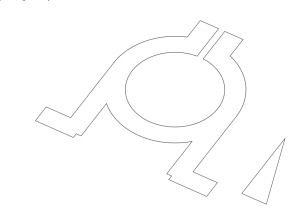
Navigate in 3D using Free Orbit. Click on Free Orbit in the navigational bar at the right, click on your mouse, hold, and move until you lot get a 3D view something like the one you run into here. Yous can drag on the "orb" and its circular handles to get the right view. A keyboard shortcut might work for yous: Hold downward the Shift key and click and drag with your mouse'due south middle (scroll) button.
Utilise the EXTRUDE command to extrude the model by 28 units and the triangle by 6 units.
On the Visualize tab, in the Visual Styles panel, click the Visual Styles drib-downwardly and choose Shades of Gray.

Phase 7: Get together the model
Follow these steps:
- Using the View cube at the upper right of the AutoCAD window, switch to the Peak view (or go to the Visualize tab, Views panel, and click Top.)
- Utilize a regular 2D mirror command to mirror correct triangle so that you have one on each side of the 3D model.
- Now use 3D orbit again to get a view like y'all see here.
-
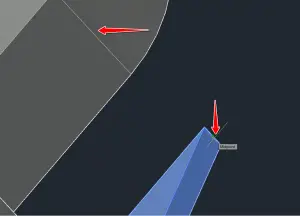
- Utilise the Move command to motion the triangle from the midpoint of its upper edge to the midpoint of the 3D line on the circumvolve quadrant. as shown in the image here.
- Plough the view once more so you tin can see the left side of the 3D model and move the left triangle in the same manner.
- Start the UNION command, select the three objects, and press Enter.
Y'all have simply merged the iii object to form one.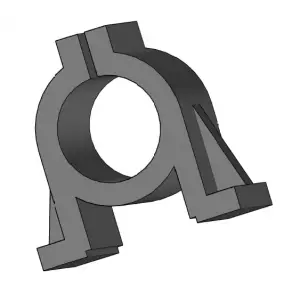
 Stage 8: Add mounting holes to the base
Stage 8: Add mounting holes to the base
One nice thing with AutoCAD when you model in 3D is that you lot can all the same use the power OSNAP and depict 2nd lines that will help you lot design in 3D.
Follow these steps:
- View the model so you can create the diagonal lines shown on the paradigm at the correct. Use the Endpoint OSNAP for the commencement and stop points. You'll have to change the view several times as y'all describe the lines.
- Create circles using the midpoint of each of the lines you merely created as the center and a radius of ii.
- Extrude the circles downward and then the height goes completely through the model. Yous tin can select and extrude them all at once.
- Subtract the 4 cylinders from the model. Offset the SUBTRACT command, select the model and press Enter, then select all of the cylinders and press Enter.
- Delete the diagonal lines.
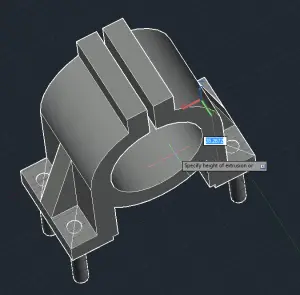
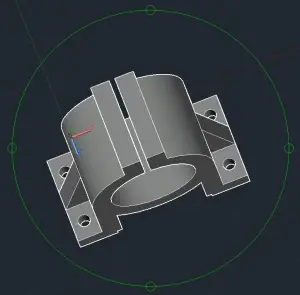
Phase ix: Fillet the sharp corners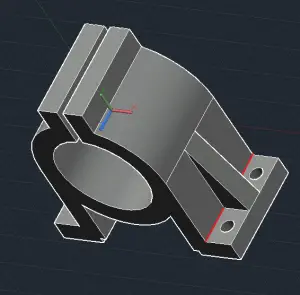
The FILLET command volition assistance you round some of the sharp edges. Follow these steps:
- Select the edges with the red marker. To make information technology easier to select just the edge, on the Abode tab, in the Choice panel, choose Border from the Filter drib down. (You might see No Filter, Vertex or Face before you make this choice.)
- Use the FILLET command to circular their shape with a dimension of R = 0.eight units. To FILLET, start the control, select the appropriate edge, enter 0.8, and printing ENTER 2 times.
- Echo the process with the opposite edge.
Phase ten: Add holes in the top
This is the final phase. Follow these steps:
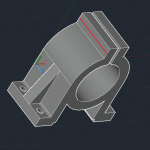
- Describe the line shown on the image below using the midpoints of the two edges.
- Create a circle of radius 2 units using the middle of the drawn line.
- Delete the line you just drew and create 2 lines using the quadrant of the circle and two edges you lot previously used. Y'all might have to rotate the model to find the object snaps.
- Now, utilise the center of those lines to create 2 circles of radius two.
- Delete the lines and extrude the iii circles using the EXTRUDE command and brand sure they go all the fashion through the model.
- Subtract those cylinders from the 3D model using the Decrease command.


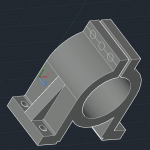

Congratulations!
Yous should end up with the following model. You might need to FILLET few more edges to take your model look identical to the model on the exercise. I hope this has been helpful to you!
Andreea hasa 21-lesson course here that y'all might find valuable.

- Author
- Recent Posts
![]()
Source: https://allaboutcad.com/tutorial-create-3d-model/
0 Response to "how to draw a 3d model in autocad"
Post a Comment